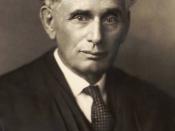Throughout Goodbye, Columbus, Phillip Roth continuously displays the ethnic social satire of Jewish people. As he clearly shows in his text, there is a distinct difference between middle-class Jews, upper-class Jews, Jews who acquired their wealth in America, and modern American Jews. Through the eyes of Neil Klugman, the protagonist of the novella, who is a middle-class Jew, Roth allows the reader to interpret the irony and satire of all four types of Jews that were presented in the story.
"Once I'd driven out of Newark, past Irvington and the packed-in tangle of railroad crossings, switchment shacks, lumberyards, Dairy Queens, and used-car lots, the night grew cooler. It was, in fact, as though the hundred and eighty feet that the suburbs rose in altitude above Newark brought one closer to heaven, for the sun itself became bigger, lower, and rounder, and soon I was driving past long lawns which seemed to be twirling water on themselves, and past houses where no one sat on the stoops, where lights were on but no windows open, for the inside, refusing to share the very texture of life with those of us outside, regulated with a dial the amounts of moisture that were allowed access to their skin."
In Goodbye, Columbus, Neil Klugman is portrayed to be a middle class Jewish-American from Newark, an area where many middle/lower-class Jewish people originate. He falls in love with a girl, Brenda Patimkin, who is from Short Hills, an area more superior and wealthier than Newark. Phillip Roth depicts the standard middle/lower-class Jewish woman in Neil's aunt, Gladys. Roth represents Gladys as this person by applying stereotypical speech, actions, and surroundings to her. Gladys has the typical characteristics of a Jewish woman as he gives her the archetypal dialect of a Jewish woman, as she...


